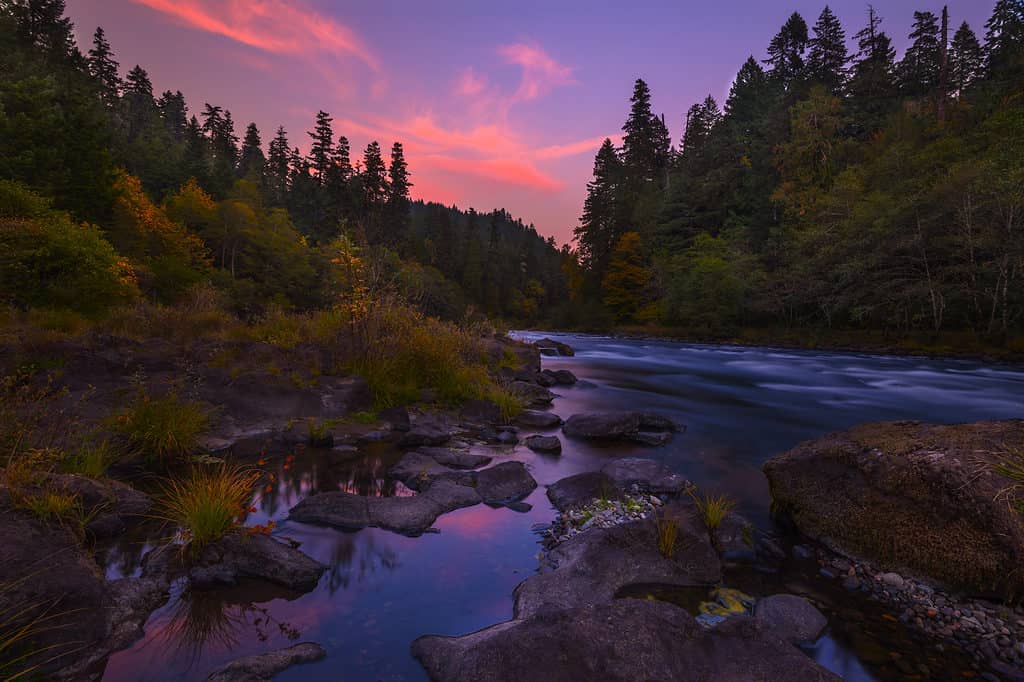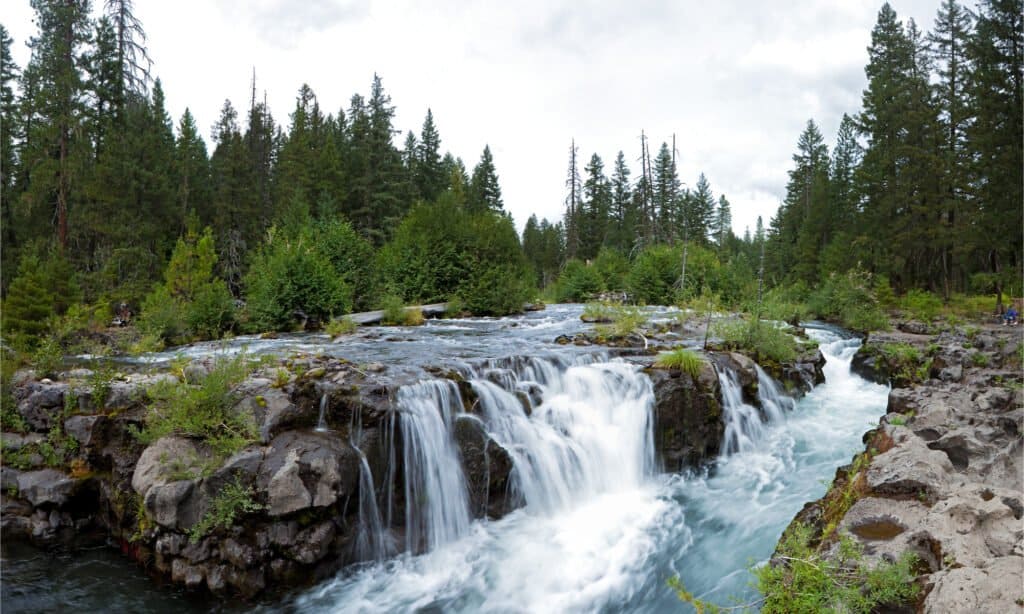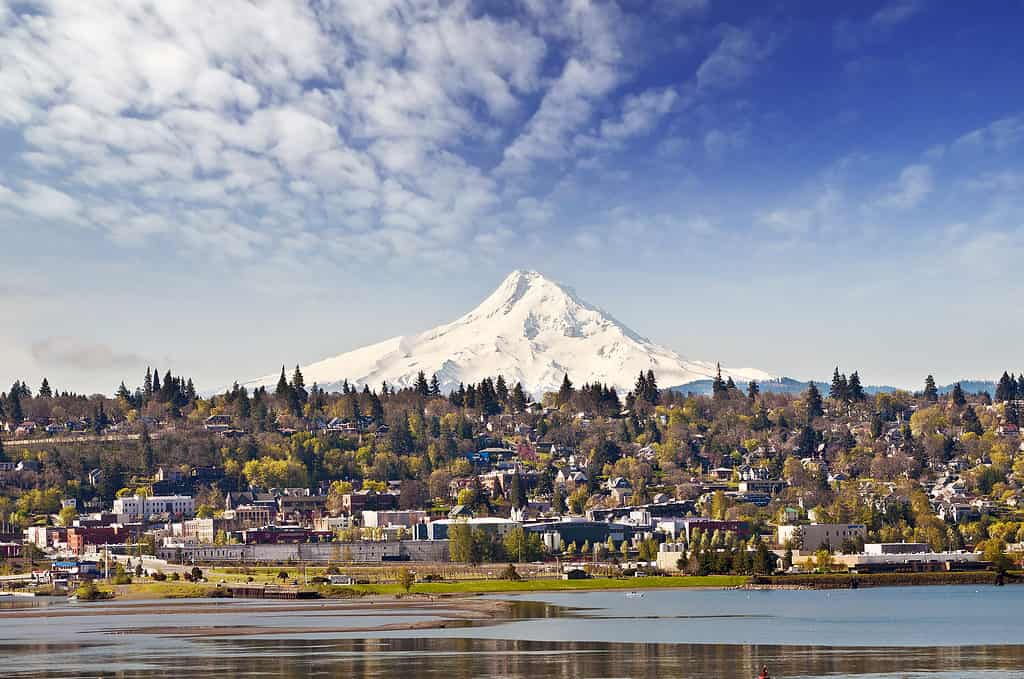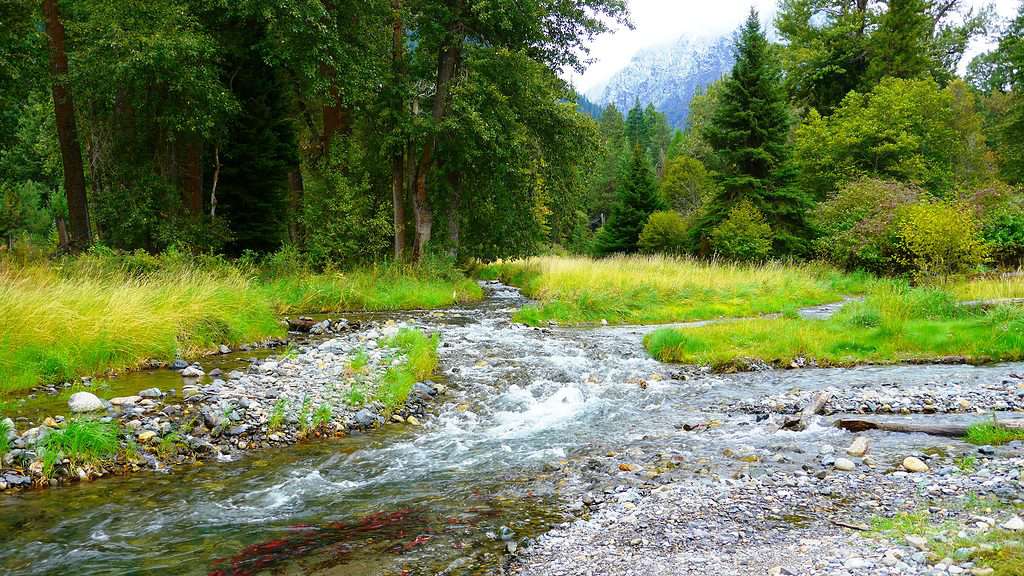Oregon is home to some of the most stunning wildlife, coastal landscapes, and bodies of water in the United States. Oregon is above California but below Washington. Thus, several rivers that intersect or originate within these three western states flow straight through Oregon. There are over 50 rivers in the state! With so many lovely rivers to explore, it can be overwhelming to know where to start. If you are planning a trip to Oregon, read on to discover the eight essential rivers to see on your journey.
1. McKenzie River
The McKenzie River is an offshoot of the larger Willamette River. It runs for 90 miles from Clear Lake to the bottom of the Willamette Valley. The McKenzie is famed for its numerous hiking and biking trails, as well as its hot springs and waterfalls. It also has the honor of residing on Portland Monthly’s list of the six most essential Oregon rivers to visit.
Two of the most beautiful waterfalls on the McKenzie River are Koosah Falls and Sahalie Falls. These are both accessible from the McKenzie River Trail. This path originates near Clear Lake and continues for 26 miles until it reaches the Willamette National Forest. It has wonderful views and plenty of unnamed falls along the way.

The McKenzie is famed for its numerous hiking and biking trails, as well as its hot springs and waterfalls.
©Michael Balada/Shutterstock.com
Those interested in these falls should keep an eye out for the Waterfalls Loop Trail, a two-and-a-half-mile circuit that leads directly to both falls. Take the Oregon 126 exit, which leads to three trailheads that all connect with the Waterfalls Loop Trail.
Another must-visit feature of the McKenzie River is Tamolitch Pool, more commonly referred to by its colloquial name, Blue Pool. This serene, sky-blue body of water occurs at Tamolitch Falls, where the McKenzie River resurfaces after flowing through subterranean lava fields. The permeable nature of the lava has a cleansing effect on the river, which accounts for Blue Pool’s striking coloration and unusually clear water. The two to three-mile hike out to Blue Pool is well worth it for the sightseeing alone. This pristine pool also makes for a great swimming spot!
The McKenzie River is also home to a plethora of fish species, including rainbow trout, bull trout, mountain whitefish, and Chinook. The white-water rapids of the Mckenzie are also perfect for rafting, kayaking, and drift-boating. For all these reasons, the McKenzie River is a must-visit if you find yourself in Oregon.
2. Willamette River
The Willamette River is a tributary of one of Oregon’s most famous rivers, the Columbia. It stretches 187 miles across nearly all of northwestern Oregon. The Willamette begins at Waldo Lake, just outside of Eugene, and flows for roughly 300 miles. It eventually joins the Columbia River just north of Portland. But this river’s drainage basin extends far further, all the way down to California. Interestingly, the Willamette is one of the top 30 largest rivers in the United States of America.

This river covers a great deal of Oregon, which means floods directly affect residents, like the Willamette Valley flood in 1996.
©Steve Morgan / Creative Commons – License
The Willamette finds many uses, from recreation, transport, irrigation, and fishing, to providing a home for ports and docks. The city of Portland has a long history as a commercial center. Ships travel from Puget Sound in Washington down through California. During the Second World War, it was also the location of a massive ship-building operation for the United States Army. The Willamette flows through just under 20 cities and nine counties. It covers so much of Oregon that roughly 70% of the state’s inhabitants live just 20 miles away from it.
The Willamette River provides the perfect background for nearly any outdoor activity you can think of. Anyone looking to swim, fish, hike, bike, hunt, or camp will find a home on this ubiquitous river. You can also just picnic and take photos of nature. Some common fish species along the river are crappie, catfish, Oregon chub, walleye, coho salmon, winter steelhead, and rainbow trout.
3. Umpqua River
The Umpqua River is 111 miles long and travels northwards from River Forks Park in Roseburg to coastal Winchester Bay. It is unique amongst Oregon’s rivers; it’s one of just four that flows from the Cascade Mountains to the ocean. It was named by David Douglas (the namesake of the Douglas fir tree), a Scottish botanist who explored North America in the 1820s. He derived the name from the Tolowa tribespeople’s term for “place along the river.”

The Umpqua River is a premier location for recreation of all kinds, including camping, fly fishing, whitewater rafting, and picnicking.
©Sveta Imnadze/Shutterstock.com
The Umpqua River has two main tributaries, referred to as the North Umpqua River and the South Umpqua River. The North Umpqua River runs for 106 miles just south of Eugene, Oregon. It is a premier location for recreation of all kinds, including camping, fly fishing, whitewater rafting, and picnicking. The most commonly caught fish along the North Umpqua are cutthroat trout, chinook salmon, winter steelhead, and coho salmon. There is even a 34-mile section of the tributary that is specifically designated for fly fishing. The North Umpqua Trail is a popular path for mountain bikers and hikers. It extends for 79 miles along the river, providing scenic views for all who visit.
The South Umpqua is a 115-mile-long tributary that runs from just east of Roseburg until it joins the North Umpqua at Singleton Park. It passes through the Umpqua National Forest as well as several towns, including Milo, Days Creek, Canyonville, Tiller, Winston, Myrtle Creek, Tri-City, and Roseburg. The South Umpqua is similar to its northern counterpart in that both are great locations for enjoying nature. It’s fun both on and off the water, whether it’s hiking and camping or fishing and rafting. Stop by the national forest and take a short hike to visit the South Umpqua Falls for a beautiful view.
4. Clackamas River
The Clackamas River runs off the Willamette River for 83 miles through the northwest of Oregon. It originates in the Cascade Mountains and flows northwest through the Mt. Hood National Forest. It then passes just under the Columbia River Gorge until it reaches the city of Estacada.
The land along the river has a long history of human settlements, traced as far back as 10,000 years ago. Long before explorers arrived from Europe, Native American tribes were using the river to fish and hunt for food. It eventually became a location for their villages. Some of these more long-lasting structures have been unearthed near the Clackamas River. They date back anywhere from 2,000 to 3,000 years ago.

The land along the river has a long history of human settlements, traced as far back as 10,000 years ago.
©Victoria Ditkovsky/Shutterstock.com
Today, the Clackamas River is split between three sectors. Seventy-two percent is designated as public land, 25% is owned privately, and the remaining 3% belongs to Native American tribes. The river provides a beautiful location for observing wildlife, especially for bird enthusiasts. Visitors can catch glimpses of bald eagles, peregrine falcons, and even the endangered northern spotted owl. There are multiple boat launch spots, docks, and areas for fishing. Some of the few remaining coho salmon and spring Chinook runs occur on this river. These fish can generally be seen in the last months of winter in the Columbia Basin section of the river. Other common fish caught on the Clackamas River include lamprey, cutthroat trout, and winter steelhead.
Biking and hiking trails occur all along the Clackamas, with the Cascading Rivers Scenic Bikeway and Clackamas River Trail among the most popular. The Clackamas River is also a high-quality source of drinking water for the entirety of Clackamas County, numbering somewhere near 300,000 people.
5. Rogue River
The Rogue River flows for 215 miles from its source in the Cascade Mountain Range all the way to the Pacific Ocean near the town of Gold Beach. This river specifically originates on Mount Mazama, in the Crater Lake National Park. The Rogue is divided into four main segments. They are classified as the Upper Rogue, Lower Rogue, Middle Rogue, and the Rogue River Canyon. Everything from camping and fishing to white-water rafting is available to those who visit the Rogue River.
Roughly 84 miles of the river were officially codified, along with eight other rivers, in 1968. This occurred with the passing of the Wild and Scenic Rivers Act, which aimed to protect specific U.S. rivers from pollution or over-development. Oregon has more federally protected “Wild and Scenic” rivers than any other state in America. The Siskiyou National Forest and the Medford District Bureau of Land Management manage parts of the Rogue. The latter is responsible for roughly 47 miles, and the former is in charge of 37 miles.

Everything from camping and fishing to white-water rafting is available to those who visit the Rogue River.
©LHBLLC/Shutterstock.com
Wildlife is a large part of the draw of the Rogue River. Often-encountered species include great blue herons, ospreys, otters, deer, and even black bears. There are plenty of fishing opportunities along the river as well. Anglers can expect to find copious amounts of green sturgeon, Chinook salmon and coho salmon, cutthroat trout, and steelhead.
Those looking to camp or white-water raft will find many places to do so. Anyone is welcome to camp along any public section of the river as long as it is undeveloped. Official campsites run by Josephine County Parks are also available. Rafting opportunities are found at multiple parts of the river, especially Hellgate Canyon and Nugget Falls.
6. Hood River
Hood River is one of the most popular recreational rivers in Oregon. It runs for 25 miles as a tributary of the larger Columbia River. The river’s headwaters originate in the shadow of its namesake, Mount Hood. The subsequent cold water flow helps facilitate the most diversified collection of endemic and migratory fish in the Columbia River Basin.

It is perhaps one of Oregon’s busiest rivers, with multiple locations for skiing, horseback riding, snowboarding, kayaking, hiking, kiteboarding, mountain biking, rafting, and even windsurfing.
©Tusharkoley/Shutterstock.com
From its source, the river heads north, where it combines with the Columbia River near the Bonneville Dam. It is perhaps one of Oregon’s busiest rivers, with multiple locations for skiing, horseback riding, snowboarding, kayaking, hiking, kiteboarding, mountain biking, rafting, and even windsurfing. Many of these activities are available in the town of Hood River, also named after Mount Hood. And no trip to the river would also be complete without visiting the town. Stop in to enjoy the many breweries, restaurants, and local businesses, or stay in one of their many charming hotels.
Fishing is common along the river, with popular species including bull trout, cutthroat trout, steelhead trout, and rainbow trout. Coho salmon and chinook salmon are also common. Hood River has also been unhampered by dams since 2010, when the Powerdale Dam was slated for demolition, returning the river to its free flow. Several waterfalls just a short hike from the river are worth visiting. These include Hole-In-The-Wall Falls, Wah Gwin Gwin Falls, Starvation Creek Falls, Punch Bowl Falls, and Multnomah Falls.
7. Columbia River
The Columbia River was initially known by the name “Rio de San Roque” after its discovery by Bruno de Heceta in 1775., It is the biggest river in the Pacific Northwest. This river runs for 1,243 miles from its source in Columbia Lake, Canada, all the way to the Pacific Ocean. It is the source of almost half of the hydroelectricity in the United States of America. The Grand Coulee Dam, one of the Columbia River’s 14 dams, has 33 hydroelectric generators!

The Columbia River passes from the Rocky Mountains of Canada down 500 miles until it reaches Washington and Oregon.
©iStock.com/Chaitra Kukanur
The Columbia River passes from the Rocky Mountains of Canada down 500 miles until it reaches Washington and Oregon. It has a maximum depth of 1000 feet, which occurs at the Wallula Gap in southeastern Washington. The Columbia River is also the second biggest river in the United States, beaten only by the Mississippi River. The largest tributaries of the Columbia River are the Spokane River, the Willamette River, and the Pend Oreille River. It passes through four separate mountain ranges — the Cascade Mountains, the Rocky Mountains, the Selkirk Mountains, and the Blue Mountains.
Fishing is a common activity along the Columbia, and the river is sought after for its high stock of Chinook salmon, coho salmon, steelhead, and sockeye salmon. Wildlife abounds across the length of the river, with often-sighted animals ranging from bald eagles, Canadian geese, and osprey all the way to cougars, snakes, moose, bighorn sheep, and bears. The Columbia River is also famous for draining more water out to the Pacific Ocean than any other river in the Americas.
8. Wallowa River
The Wallowa River is a 55-mile-long tributary of the larger Grande Ronde River, which originates at 10,000 feet in the Eagle Cap Wilderness in the Wallowa Mountains and ends at Wallowa Lake, just outside of Joseph, Oregon. The name of the river comes from the Nez Perce tribe, who made their home on the Columbia River Gorge about 12,000 years ago. In their language, “wallowa” means alternatively “fish trap” or “winding water.”

The name of the river comes from the Nez Perce tribe, who made their home on the Columbia River Gorge about 12,000 years ago.
©Rick Obst from Eugene, United States, CC BY 2.0, via Wikimedia Commons – License
The Wallowa River offers recreational activities such as hunting, kayaking, float boating, canoeing, camping, and fishing. You can catch rainbow trout, blue ribbon trout, chinook, mountain whitefish, and steelhead.
There are a few boat launches in Minam, as well as Troy’s Oasis, Boggan’s Oasis, and Mud Creek. Boat rentals are available at a few locations – the Minam Store, Northwest Rafting Company, and the Winding Waters River Expeditions. The wildlife along the Wallowa River includes everything from mule deer and whitetail deer to elk, black bears, bald eagles, and bighorn sheep.
The photo featured at the top of this post is © Bureau of Land Management Oregon and Washington / CC BY 2, Flickr – License / Original
Thank you for reading! Have some feedback for us? Contact the AZ Animals editorial team.






